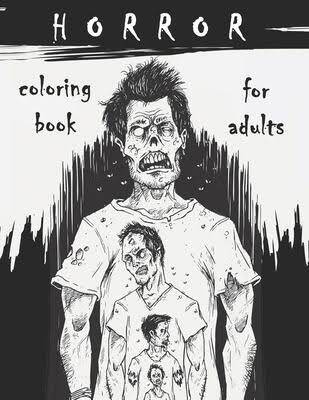Who said that scary things aren’t for kids? Or that coloring books aren’t for adults? Both of these things are proven dreadfully wrong with the best coloring books inspired by the horror genre. Yes, they’re a thing. Your favorite monsters jump off the page as you color in between the lines and create a ghoulishly gorgeous work of art – all while relieving stress and soothing the mind with a set of crayons as your guide. If you’re looking to unwind and relax after a long day – and need something a bit more abnormal than the typical Netflix and wine – try these horror coloring books for adults to channel your dark side with a bit of creepy color.
The Beauty Of Horror: A GOREgeous Coloring Book

This horror coloring book by Alan Robert is one of the most popular on the web, and you’ll see why as you glance into its pages. GOREgeous features “an onslaught of severed heads, monsters, deadly weapons, and skeletal remains” as you “visit burial grounds, the zombie apocalypse, serial killer lairs and gruesome torture chambers.” Their words… cute, right? Invest in this page-turner that has tons of gore-geously good reviews on GoodReads on Amazon, and get that red crayon ready for all the blood, clown noses, and leftover guts. You’re going to need it.
Horror Coloring Book for Adults : Horror Stress Relieving Illustrations with Scary Monsters, Creepy Scenes, and a Spooky Adventure

This horror coloring book isn’t for the faint of heart. You won’t find any “good witches” or soft scares within these black-and-white pages – only the most terrifying and intricate illustrations that will freak you out and frustrate you as you try desperately to color within the lines. Trust us, once you see the complexity of these designs, you’ll see that you’ll need the entire box of crayons. That being said, this horror coloring book is ideal for the artsy scare lover… and you’ll want to stick this art up on your bedroom wall for the most gorgeous horror house on the block.
Zombie Coloring Book

Take a break from witches, skeletons, and killer clowns as you go back to basics with a horror staple: zombies. These undead creatures will always have a place in your favorite scary movies and TV shows… and now on your nightstand, too. Choose from 20+ zombie illustrations – ranging from ugly and gross to interesting and a bit cute – and fill them in with your favorite colors to bring life back into your relaxation routine with a few undead monsters. Sure, the title of this book is a mouthful, but Zombie Coloring Book really is an incredible habit for everybody!
Alice’s Nightmare in Wonderland Coloring Book

Plenty of children’s movies are a lot more creepy once you watch them as an adult, like Alice in Wonderland. Between the Chesire Cat’s scary smile and the Queen of Hearts yelling about beheading children, this classic Disney film is almost as scary as any horror film from the early 2000’s. And it gets even more horrifying with this adult coloring book that features demonic versions of the film’s classic characters. A giant, murderous rabbit is something that you didn’t even know you needed until now, and you can make him any color you like for ultimate nightmare fuel.
The Beauty of Horror 2: Ghouliana’s Creepatorium Coloring Book

It’s pretty rare in the world of horror for the sequel to be just as spooky and stunning as the original – unless we’re talking about horror coloring books for adults. Ghouliana’s Creepatorium has just as many distorted ghosts and scary skeletons as the GOREgeous book that we told you about earlier… and it doesn’t even need to be Halloween to stick these finished illustrations up on your refrigerator. Let loose and embrace your inner artist with these spooky designs that never go out of style… and know that there are plenty more coloring books to try in the The Beauty of Horror lineup. Thanks, Alan Robert!

I am a lifelong pop culture junkie with immense passion for all forms of art and entertainment. On a typical weekend, I can be found at a concert or musical, chasing ghosts on the Haunted Mansion at Disneyland, or watching way too many makeup tutorials on YouTube.
